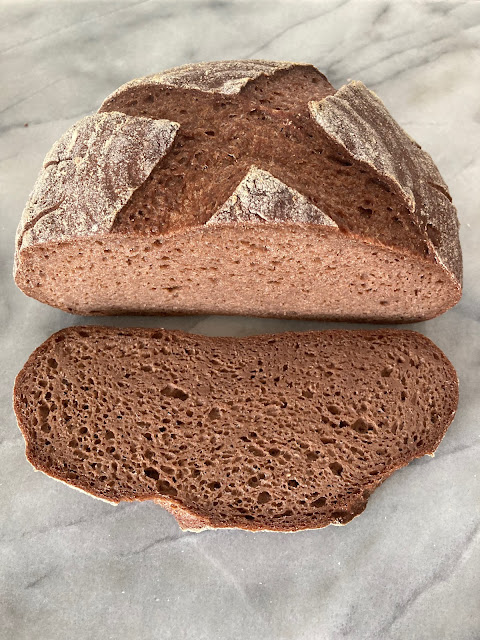Marbled "Rye" Style Gluten-free Sourdough Bread
Introducing my latest gluten-free sourdough creation, this bread is very soft, fairly sour, high in whole grains, and has a strong rye-like flavor. It's going to make a great Reuben sandwich!
Ingredients and Equipment
Here’s a list with affiliate links to some of the products I used in this recipe:
Kitchenaid Artisan Stand Mixer
Replacement Kitchenaid attachements
Of course, you don't need a pantry full of new equipment to be able to make this recipe. You can easily mix by hand in a regular mixing bowl, and bake in any lidded vessel that's rated for high heat.
Marbled "Rye" Style Sourdough Bread Recipe
First Mix: 20 min
First Rise: about 12 hours
Second Mix and shape: 10-20 min
Second Rise: 2-5 hours
Make two doughs simultaneously in separate bowls.
Dark Dough:
Mix the dry ingredients together:
65g brown teff flour
60g light buckwheat flour
40g quinoa flour
15g whole psyllium husk
4g salt
Add the wet ingredients and mix until completely incorporated:
20g sourdough starter
240g spring water
Cover and let rise for about 12 hours.
Light Dough:
Mix the dry ingredients together:
65g ivory teff flour
60g light buckwheat flour (don't use dark/purple buckwheat, it will be too dark in color. Sub a lighter color grain if needed, possibly millet)
40g quinoa flour
15g whole psyllium husk
4g salt
Add the wet ingredients and mix until completely incorporated:
20g sourdough starter
240g spring water
Cover and let rise for about 12 hours.
50g tapioca starch (also called tapioca flour)
1 tsp coriander (optional)
1/4 tsp caraway (optional)
6g (1/2 TBSP) apple cider vinegar
6g sugar
50g tapioca starch (also called tapioca flour)
1 tsp coriander (optional)
1/4 tsp caraway (optional)
6g (1/2 TBSP) apple cider vinegar
6g sugar
Mix the dough with paddle, dough hook, or by hand until everything is well incorporated and the dough is soft and springy. Turn out each dough onto a floured work surface one at a time. The dough should be workable with a little flour but if not you can let it rest 10 minutes to firm up.
Roll out each dough to approximately the same size, about 8x10 inches or a bit larger if you can manage it. The larger you roll it out, the thinner the swirls will be.
Place one sheet of dough on top of the other with the length of the rectangle pointing away from you. The bottom sheet will be the outside of the loaf. Press them together or roll them with a rolling pin.
Do a towel roll for a batard shape: fold the right and left sides in a little bit, then, starting with the farthest edge, roll the dough up toward you into a tube. Place the dough seam side up in a floured banneton basket. Tuck the ends up if needed, and pinch the seams closed (see video).
Let the dough rise about 30-50%, which could take anywhere from 2-6 hours, depending on conditions. For best oven spring, it's better to under-proof a little than to over-proof. After it starts rising, do the finger poke test occasionally to see how proofed the dough is. Bake when the dough has risen a bit, but still springs back up easily when depressed.
Preheat the oven to 450°f/230°c with a dutch oven or cloche inside.
Turn the dough out onto parchment paper or directly into the baking vessel. Score the top lengthwise.
Bake for 30 minutes covered, then another 15 minutes uncovered. The loaf is done when it sounds hollow when tapped. If it still sounds wet inside, bake another 5-7 minutes or however long is needed for it to bake completely.
Here's a video demonstrating the "knuckle test" for bread doneness:
Enjoy your gluten-free bread!






Comments
Changes I made were:
-subbed 30g of millet and 10g of sorghum for the quinoa
-let it ferment for 24 hours instead of 12. The sour taste was very strong.
-I added 10g of teff and 10g of water after the rise because it was every so slightly too dry. I think my substitution required slightly more water and I figured the 10g of teff was a little bit of fresh food for the starter.
-I also added 10 minutes of bake time.